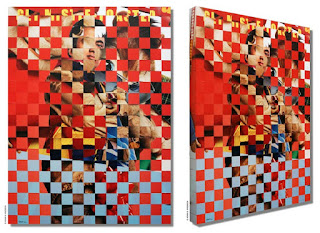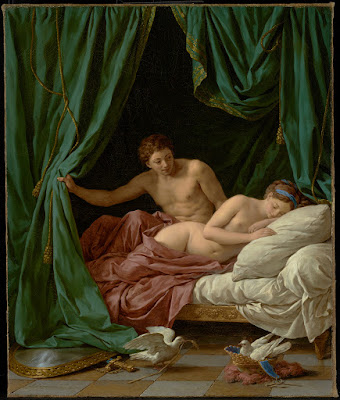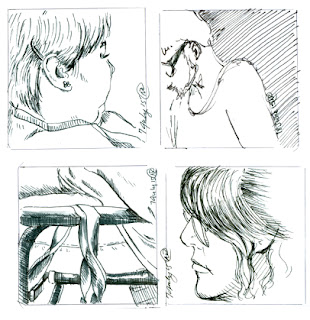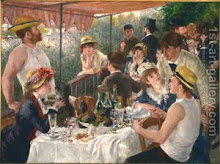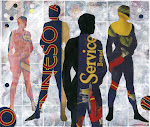Monday, December 31, 2018
Saturday, December 29, 2018
Drawing Tip
Draw what interests you, you'll improve much faster. Don't just
draw what you think will please others. And don't feel you have to be perfect. Enjoy the journey. Practice is the key - volume, volume, volume.
Friday, December 28, 2018
Thursday, December 27, 2018
Wednesday, December 26, 2018
Trip to Getty Art Center
The nude human figure, both male and female, has been central to European art for centuries. During the Renaissance of the 1400s and 1500s, artists across Europe used the nude to explore religion, nature, human relationships, and beauty itself. But artists’ approach to the nude were not monolithic, nor were these works received without considerable controversy. Although created long ago, these works continue to inform contemporary attitudes toward the nude human figure in art.
Renaissance artists transformed the course of western art history by making the nude central to their art. Drawing inspiration from classical sculpture and the study of the live model, these artists created lifelike, vibrant, and sensual representations of the human body.
Renaissance artists transformed the course of western art history by making the nude central to their art. Drawing inspiration from classical sculpture and the study of the live model, these artists created lifelike, vibrant, and sensual representations of the human body.
The nude—the unclothed or partially clothed human body—has been featured in European art for millennia. After 1400, with the waning of the Middle Ages, artists depicted nudes as increasingly three-dimensional, vibrant, and lifelike— in short, more immediate and real. They employed diverse means: in Italy through a return to the models of ancient Greek and Roman art, and in northern Europe through refinements to the technique of painting in oils that enabled painters to capture textures—of flesh, of hair, of the sparkle in an eye—with unprecedented truth to nature. In concert with new scientific approaches, artists across Europe studied nature—including the human body—with increasing specificity and deliberation.
The meaningful depiction of the human form became the highest aspiration for artists, and their efforts often resulted in figures of notable sensuality. For Christians, however—who represented most of European society at the time—the nude body could be disturbing, arousing personal desire. Their conflicted responses are mirrored in our own body-obsessed era, filled with imagery of nudity.
The Renaissance Nude examines the developments that elevated the nude
to a pivotal role in art making between 1400 and 1530. Organized thematically, the exhibition juxtaposes works in different media and from different regions of Europe to demonstrate that depictions of the nude expressed a range
of formal ideals while also embodying a wide range of body types, physical conditions, and meanings.
In addition to viewing the exhibit, I strolled over to view the paintings. Several of my favorite painting housed in their collection:
Tuesday, December 25, 2018
Monday, December 24, 2018
Sketchbook Tips to Help You Make Art Now
Ever wanted to keep a sketchbook but you weren’t sure where to
start? Or maybe you’ve been sketching for a long time but need a little pick me
up. Take a look at these 10 sketchbook tips to help you develop your own
sketchbook practice!
1. Make It Yours
A
sketchbook doesn’t need to be expensive, and it doesn’t have to be purchased in
an art store. There are no rules about whether it needs to be hardbound,
wirebound or softcover, or about what kind of paper is inside. The important
thing is to use the sketchbook you like, and to make sure the paper will
support your favorite art materials, whether they’re pencils, pens, paints or
something else.
Find
your favorite sketchbook brand online, browse through what’s available at your
local stores, make your own book, use whatever you have lying around, or
discover one when you’re out and about. For that matter, if you prefer to use a
digital tablet, you can go that route, too! As long as you love it and want to
use it, it’s the sketchbook for you.
2. Keep It Portable
Decide
what size sketchbook is easiest to carry around with you. Many people prefer
pocket-sized sketchbooks, while others like them a little larger. Whatever your
preference, make sure it’s easy for you to transport so you’ll have the
opportunity to sketch anywhere you go. You can always find a spare minute
standing in line, in a waiting room, or on a break to sketch something,
provided you take your sketchbook with you when you leave the house. If you
like, you can keep larger sketchbooks in your home and simply leave your
on-the-go sketchbook in your bag or car to make sure you never forget it.
3. Relax and Accept Imperfection
Not
every page in your sketchbook will come out exactly the way you plan, and
that’s okay. Don’t be afraid to play around, capture ideas, or quickly draw
what you see. Allow yourself to simply enjoy the act of sketching and the
process of creating rather than worrying about the result. After all, if you
decide you don’t like where the page is going, you can always turn to the next
one. But don’t get into the habit of tearing out pages. Even the things you
don’t like today might later become fodder for a new idea.
4.
Draw Every Day
Use
your sketchbook every day, even if it’s only for a few minutes. Consistent
practice will improve your artistic abilities dramatically. Your accuracy,
speed and visual vocabulary will improve, and with it your confidence.
5. Experiment
Your
sketchbook is a place to experiment and play around. Try new and unexpected
materials and various styles. Make marks and messes. Add color, paper or other
ephemera to your pages. Use your sketchbook to discover what you like and what
you don’t. There are no rules except the ones you impose on yourself.
6. Divide the Page
If
having an entire blank page to work on feels too expansive, try breaking down
the page into smaller shapes you can draw within. Post-it Notes are handy to
use as templates. Just draw around them to get a smaller frame you can use to
focus your sketch. Try filling an entire sketchbook spread with frames and
capture quick moments or details of objects instead of trying to reproduce the
entire thing.
7. Jumpstart Your Pages
Sometimes
we just don’t know what we want to draw or how we should go about tackling that
dreaded white page. If this causes you to avoid your sketchbook, try marking up
the pages in advance to take the pressure off. Paint a few pages for a pop of
color, make random lines to surprise yourself with later, or let someone else
doodle or draw things for you to work around. If you have a young child, let
them at a page or two with a few crayons. Once the pages are no longer
pristine, you’ll worry less about making mistakes or playing around yourself.
8. Use It for Everything
Turn
your sketchbook into a constant companion and use it for everything. You can
doodle or sketch from observation. You can create patterns or practice hand
lettering. Sketch out concepts for larger art pieces you want to create, or
test art materials. Collect and attach things you like or don’t want to lose,
like tickets, business cards, leaves or flowers. Paste in pictures or decorate
your pages with washi tape. You can do anything–everything–you want to make
your sketchbook personal and useful to you.
And
don’t leave your life out of your sketchbook. Make grocery lists into art. Draw
out your favorite saying. Make an artful flowchart to plan your next vacation.
There is art in your everyday, so put it in your sketchbook.
9. Write in Your Sketchbook
Not
everything in your sketchbook has to be an image. You can make notes about
drawings, or just keep notes in general, including grocery lists, to-do lists
or calendars (wouldn’t they be fun to illustrate later?).
Use
it as a diary, make lists or collect quotes. Write down things that inspire
you, observations you make and snippets of dialogue you overhear. Create a list
of artists you love, techniques you want to try or things you want to practice.
Keep websites you like to visit or that have resources you find useful. Make
lists of artists you draw inspiration from, social media feeds and Pinterest board ideas. There are dozens
of ways to utilize writing in your sketchbook, so don’t be afraid to include
it.
10. Date Every Page
Be
sure you date each page in your sketchbook. This will help you see your
progression over time, and it will create a visual record of each year. Going
back to look at the places you went, the materials you tried, and the drawings
or paintings you liked (or didn’t) will be a rewarding experience and may even
spark new creative ideas. And while you’re at it, don’t forget to sign your pages,
too!
Ultimately,
how you use your sketchbook is up to you, but the most important thing to
remember is that your sketchbook should be personal and useful. It should be
exciting to take out and play in your sketchbook, so loosen up, do what you
enjoy and let yourself be inspired by the things you create.
Sunday, December 23, 2018
Subscribe to:
Comments (Atom)

















